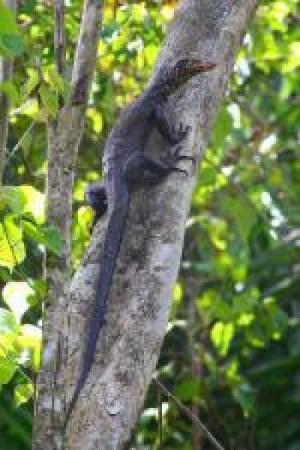Second Komodo Dragon Relative Discovered This Month!
Posted by: Loren Coleman on April 28th, 2010
George Foulsham, Office of Public Affairs, UCSB, has issued this press release announcing a new species of Varanus has been discovered, the second such announcement this month!!

This is Varanus obor, the Sago monitor, or Torch monitor lizard. Credit: Valter Weijola.
(Santa Barbara, Calif.) –– A newly discovered species of monitor lizard, a close relative of the Komodo dragon, was reported in the journal Zootaxa this week by a professor at UC Santa Barbara and a researcher from Finland.
Sam Sweet, a professor in the department of Ecology, Evolution and Marine Biology at UCSB, and Valter Weijola, a graduate student at Abo Akademi University in Turku, Finland, are the first to describe the distinctive lizard, which lives in the Moluccan islands of east Indonesia. Sweet is an authority on monitor lizard biology.
The scientific name of this lizard is Varanus obor; its popular names are Torch monitor and Sago monitor. It’s called Torch monitor because of its bright orange head with a glossy black body. Obor means torch in Indonesian. It is a close relative of the fruit-eating monitor lizard recently reported from the Philippines. The Torch monitor can grow to nearly four feet in length, and thrives on a diet of small animals and carrion.
The Torch monitor exists only on the small island of Sanana in the western Moluccan islands. A unique aspect of this geographical region is the lack of mammalian predators, which may have given reptiles the space to evolve as the top terrestrial predators and scavengers. Several million years ago, this island was situated near New Guinea, and it is possible that the lizard lives on as a relic from that period. It is the only black monitor in its lineage, and the only monitor species anywhere that has evolved red pigmentation.
Sweet describes an important biological context: “East of Wallace’s Line –– the boundary between Asian and Australian domains –– there are no native carnivorous mammals, and monitor lizards fill that role. There are more species there, doing more different things ecologically than in Africa or South and Southeast Asia, where competition and predation by mammals tend to keep monitor lizards down. East of Wallace’s Line in Indonesia, New Guinea, and Australia, monitor lizards are on the top of the heap. It emphasizes again how little we know about some tropical regions, to find an animal so strikingly colored and so large only last year.”
Weijola discovered the lizard last spring, and returned with Sweet in late 2009 for five weeks to do studies and take photographs of the animal. The Torch monitor is most common in the coastal sago palm swamps and belongs to the mangrove monitor, V. indicus group.
About Loren Coleman
Loren Coleman is one of the world’s leading cryptozoologists, some say “the” leading living cryptozoologist. Certainly, he is acknowledged as the current living American researcher and writer who has most popularized cryptozoology in the late 20th and early 21st centuries.
Starting his fieldwork and investigations in 1960, after traveling and trekking extensively in pursuit of cryptozoological mysteries, Coleman began writing to share his experiences in 1969. An honorary member of Ivan T. Sanderson’s Society for the Investigation of the Unexplained in the 1970s, Coleman has been bestowed with similar honorary memberships of the North Idaho College Cryptozoology Club in 1983, and in subsequent years, that of the British Columbia Scientific Cryptozoology Club, CryptoSafari International, and other international organizations. He was also a Life Member and Benefactor of the International Society of Cryptozoology (now-defunct).
Loren Coleman’s daily blog, as a member of the Cryptomundo Team, served as an ongoing avenue of communication for the ever-growing body of cryptozoo news from 2005 through 2013. He returned as an infrequent contributor beginning Halloween week of 2015.
Coleman is the founder in 2003, and current director of the International Cryptozoology Museum in Portland, Maine.









